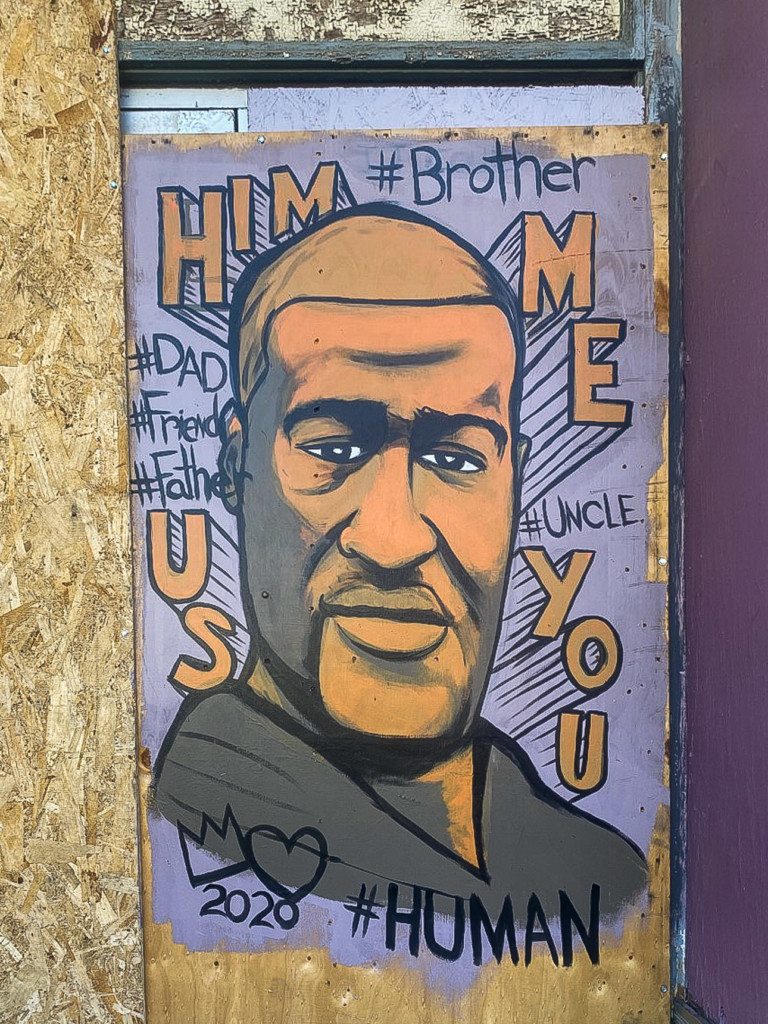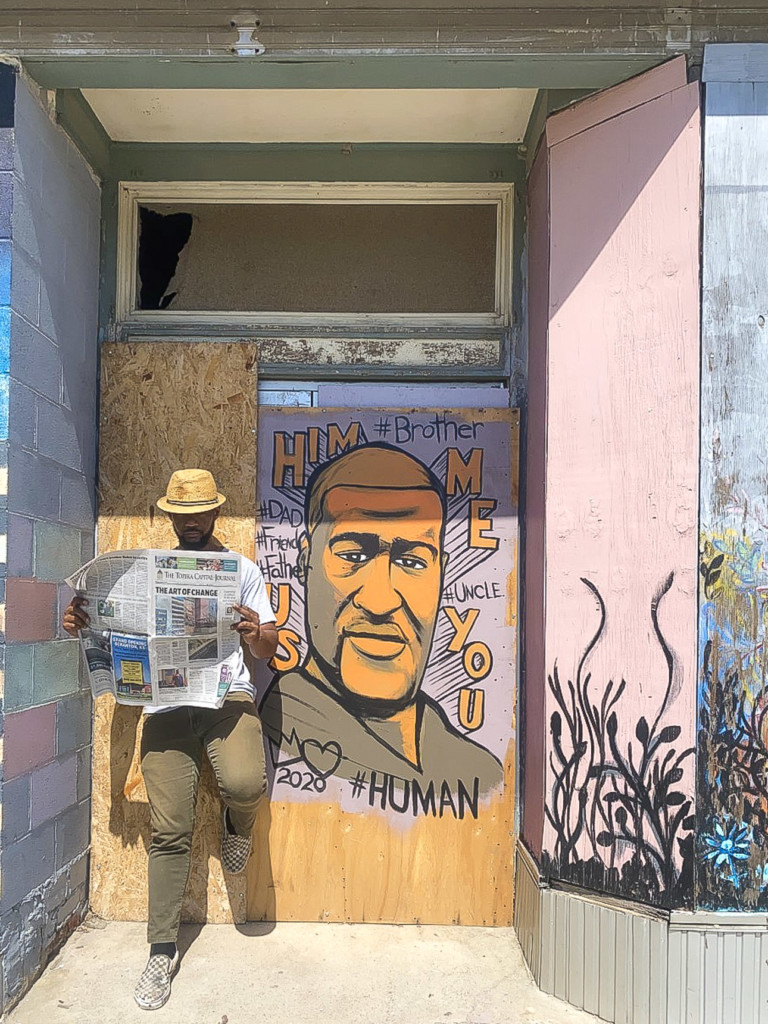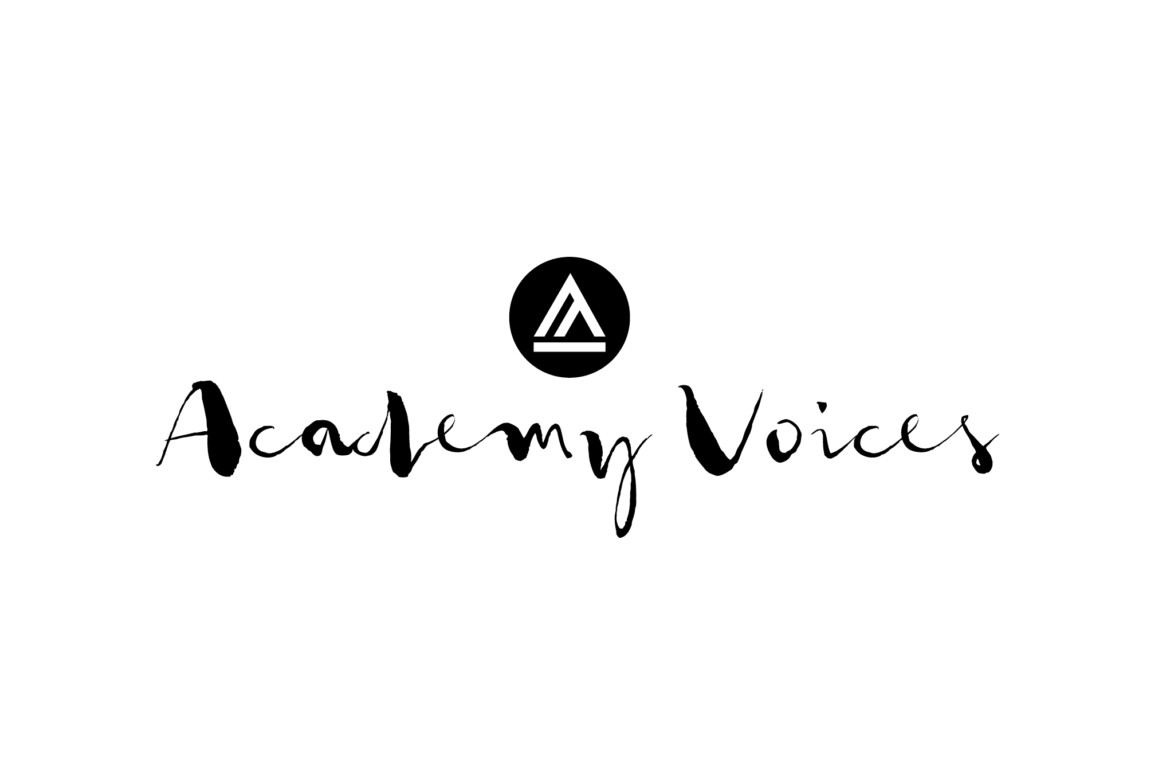By Greta Chiocchetti
For Jordan Brooks, a student of the School of Illustration at Academy of Art University, art is a way to remind us of what it means to be human. As the creative mind behind the Art LOVE studio, based in his hometown of Topeka, Kansas, Brooks works primarily as a painter, illustrator, and muralist, but he also dabbles in sculpture and videography. But no matter the medium, Brooks’ self-expression is inspired by the shared experiences that make us human.
His approach earned him national acclaim with his latest piece—a tribute to George Floyd, who was killed by police in late May and whose death spurred international protests against racial inequity and police brutality. The mural, which depicts a colorful portrait of Floyd surrounded by words describing him, like “father,” “uncle,” “brother,” and of course, “human,” was featured in USA Today alongside similar works from around the country.

“I wanted to do something positive that would stimulate some uncomfortable conversations in my community,” said Brooks of his tribute, located on an abandoned building in the arts district of North Topeka.
In an interview with Art U News, Brooks spoke about his artistic journey, the Black Lives Matter movement, and how art can be activism.
Were you a creative kid? How did your interest in art develop?
I think I’ve always been interested in comic books and cartoons. I was also really into history—especially the pictures in the history books. I always liked pictures that had symbolism in them—when the picture itself tells you something and you can just tell exactly what’s going on without any captions.
My mom is an artist herself, so I started copying her. I used to give her things to draw. I’d come with ideas, and then she’d be like, ‘Why don’t you just do it yourself?’ So I started doing it myself, and I got better at it than her and everyone around me.
How would you describe your artistic style?
I would say it’s very contemporary and very colorful. I use a lot of bright colors. I can sometimes tone things down or make them look more realistic, but I feel like we live in a day and age right now that we’re so hit with reality all the time. I create art that is more of a release, an escape, more therapeutic. I like to pull on heartstrings and remind people of their human nature. So whether I’m painting a picture of a family or when I’m painting like a superhero or something, I always try to connect it emotionally. I think that’s a big part of me.
How did you get the idea for your George Floyd mural?
There’s an arts district in Topeka, which we call “NoTo”—short for North Topeka. It’s basically this cute downtown area, with narrow streets and old school buildings. Our community has embraced and beautified the area and made it into a sort of arts district. And right in the middle is one of the biggest buildings, which is actually abandoned; it used to be a government building, but they moved further downtown. Since then, it’s become a popular spot for murals.
Honestly, my mural was more of a guerrilla graffiti-style operation. It was completely unplanned. I was driving through the arts district that afternoon and I already had the paint in my trunk, and I saw that they had removed the building’s old door and replaced it with a brand-new wood. Before it had years and years of paint, and then all of a sudden, this fresh wood. So I had this inspiration hit me, that I wanted to do or show something that would be an outlet, something positive that would maybe stimulate an uncomfortable conversation in my community, you know, as positive as it could possibly be. As angry as I am as a Black man about everything that’s going on right now in America, I think there’s always gonna be a better way to do things, in terms of the protesting and destroying things. This was kind of like pushing the ball into someone else’s court and giving them the chance to work through this themselves, but setting it up in a way where it’s not a negative message so that it would be more constructive than divisive.
That is the reason why I put the words father, uncle, brother, dad, etc., around him, and painted him in that bright color orange—I didn’t want people to focus so much on the skin color, but the human issue.

Does a lot of your art deal with Black Lives Matter?
This was probably the closest thing—most of my art has nothing to do with the movement. I think it’s a part of my nature—the Black Lives Matter movement—with me being a Black man. So, it’s always a part of my perspective. But I think if I try to move forward pushing that perspective, sometimes I think people will lose out on a lot of the other elements that make up who I am.
I definitely appreciate how the Black Lives Matter-related art being produced right now is leading to more conversations, but sometimes I feel like you can end up just being labeled not just an artist but a “Black artist.”
How do you feel about the label of a “Black artist,” as opposed to simply an artist?
I think it can be a double-edged sword. I do want to be seen as a very positive, strong Black male, but I really want to be seen as just a positive strong male. Just a human, a positive human. I think, just like anything else, when you add more labels, it can be a good thing but it can also be a bad thing. It gets you more attention, but it can also put the wrong attention on you too. Like when you’re presenting an idea for a commission piece or a mural or some other project, and you have more than two or three Black figures in your artwork, you must just paint nothing but Black people.
What are you working on right now?
I’m currently working on a new collection of art, which is mostly family-oriented. I guess you could say it’s kind of autobiographical. So it’s kind of revisiting my past and learning more about my history. I found all these old pictures of my family and I started working with those and painting some of those.
I’ve also started working on my first children’s book, an illustrated tale called “The Artist Who Lost His Colors.” I’m illustrating and writing it myself—the story’s done, I’m just working on the production side of it. I’m hoping it will be finished by spring or summer of 2021.
To see more of Brooks’ work, please visit https://www.jordanebrooks.com/.
